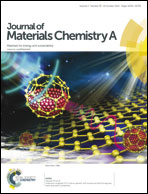Reinforced conducting hydrogels prepared from the in situ polymerization of aniline in an aqueous solution of sodium alginate†
Abstract
By using the in situ polymerization of aniline in an aqueous solution of sodium alginate, we prepared reinforced conducting hydrogels (PANI–SA) with good conductivity (∼10−3 S cm−1). SEM images indicated that the microstructure of PANI–SA hydrogels was a typical 3D nano-fiber network formed by the entanglement of the PANI and SA molecular chains, leading to a good compressive strength (∼41 kPa). Because the system does not contain any adhesives and conducting fillers, the PANI–SA conducting hydrogels with self-supported structures can be directly employed as electrode materials for supercapacitors. A study of cyclic voltammograms indicated that the currents of the cathodic peak significantly increased with an increase in the scan rate, indicating that the electrode materials possess good responsiveness. As a reference, traditional compressive tablet electrodes were also prepared by mixing the powder of PANI–SA xerogels, adhesive and conducting filler. The results of galvanostatic charge/discharge and impedance show that PANI–SA hydrogels possess longer discharge times, higher specific capacitance and lower electronic resistance in comparison with compressive tablet electrodes. After 1000 cycles of charge/discharge, there is almost no difference in the retained specific capacitance between PANI–SA hydrogels electrodes and compressive tablet electrodes. The easily fabricated PANI–SA conducting hydrogels show great potential as electrode materials for supercapacitors.


 Please wait while we load your content...
Please wait while we load your content...